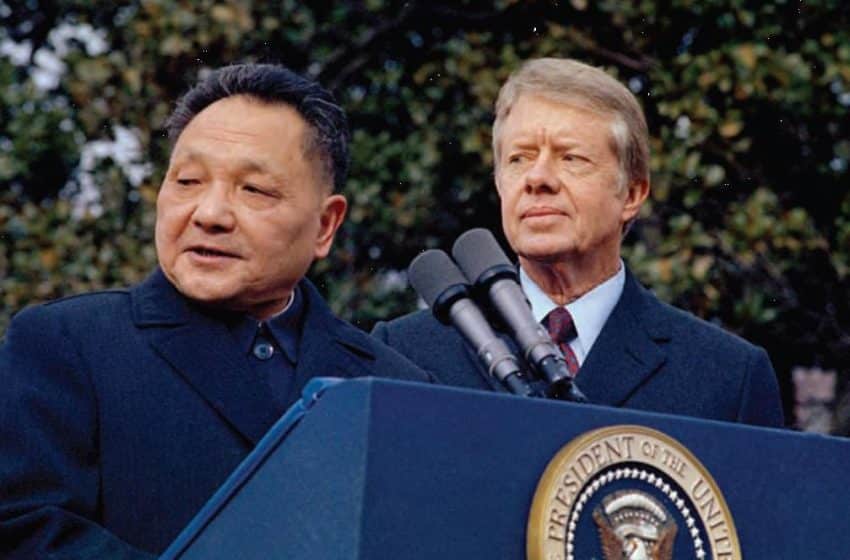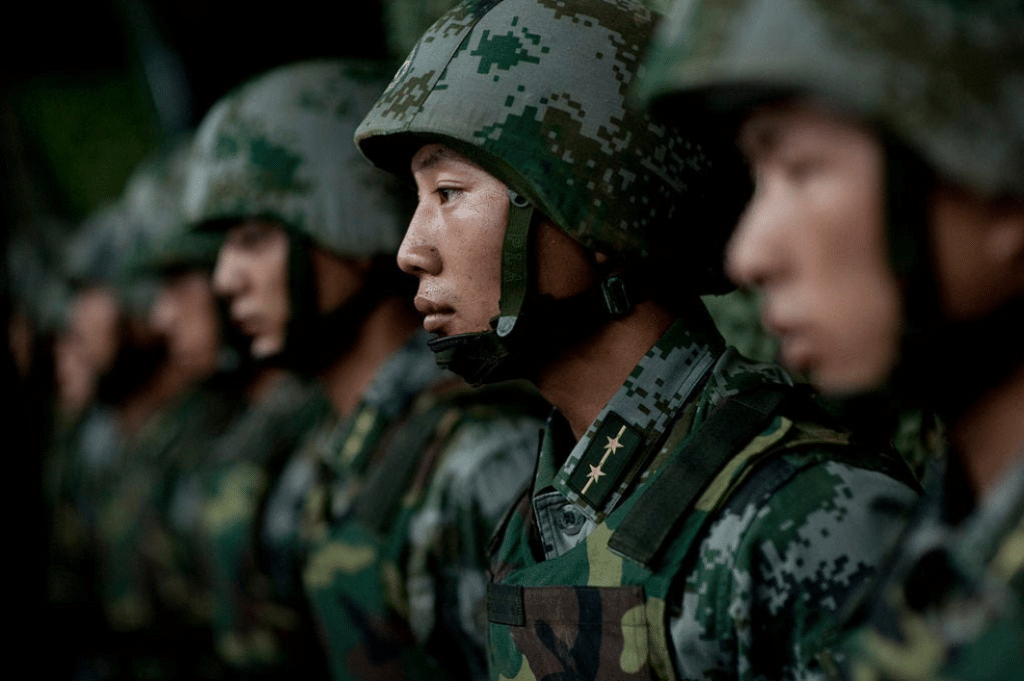Diplomatic Panda-Monium! The Fuzzy Face of U.S.-China Relations
- Analysis
 Yingyi Tan
Yingyi Tan  Miranda Wilson
Miranda Wilson- 10/24/2023
- 0
This article analyzes the historical and contemporary aspects of panda diplomacy between the U.S. and China, considering the political context and public opinion in both countries. It examines the fluctuations in this exchange as a lens through which to observe the shifts in the U.S.-China relationship over time.
If you hope to see a panda bear within the U.S., you should plan a visit to the zoo soon. The Smithsonian’s National Zoo will return its three pandas to China in November of this year, and the four pandas at the Atlanta Zoo are scheduled to return in 2024 as their loan ends.
But what do pandas have to do with politics? China has a long history of “panda diplomacy.” However, recent tensions in the U.S.-China relationship are manifesting in more ways than trade wars and TikTok controversies: the U.S. might be panda-less for the first time in more than 50 years by the end of 2024.

What is Panda Diplomacy?
Panda diplomacy, the practice of loaning or gifting giant pandas to other countries as a symbol of friendship and an emblem of China, marks a unique facet of international affairs. These adorable, bamboo-munching “ambassadors” have become global icons, transcending borders to enchant people of all ages. Moreover, their travels often mark China’s significant forays in its foreign policy. Currently, there are at least 65 pandas outside of China in 18 countries.
The most historic instance of panda diplomacy was China’s gift of pandas to the U.S. in 1972, which helped thaw Sino-American relations during the iciness of the Cold War. In the next 50 years, more than 10 giant pandas were sent to four zoos in the U.S. However, in light of the deteriorating U.S.-China relationship at present, there are no public signs of the continuation of this 50-year-old exchange agreement. Other countries participating in panda diplomacy, for example, Russia and South Korea, have panda loans that extend into 2030.

Panda Goodwill: Building Strategic Partnership
As the only natural habitat for giant pandas in the world, China offered pandas as diplomatic gifts as early as the Tang Dynasty (618–907). However, the concept of “Panda Diplomacy” was not officially coined until the Cold War in the 1950s, when the newly founded People’s Republic of China began to bestow pandas upon foreign nations to establish strategic alliances. The first gifts were in 1957 to President Nikita Khrushchev of the Soviet Union and then Kim Il-Sung of the Democratic People’s Republic of Korea. China gifted a total of 24 pandas as “goodwill ambassadors” to nine nations from 1957–1983.
In February 1972, President Richard Nixon’s historic visit to China cracked the longstanding walls in Sino-American relations. During the last state banquet before their departure, First Lady Pat Nixon mentioned to China’s Premier Zhou Enlai her love for pandas. Pandas were already a popular animal in the U.S. by then, as Su-Lin, a wild panda captured by Ruth Harkness, spurred public sensation at the Chicago Brookfield Zoo.
Zhou Enlai agreed to the request, and a male and female giant panda known as Xing Xing and Ling Ling soon made their way to Washington as diplomatic gifts from China. The American media used the term “panda-monium” to describe the widespread excitement and anticipation for the arrival of the two panda envoys. Basked in celebrity treatment, Pat Nixon welcomed their landing, and 75,000 people waited on a rainy day for their debut at the Smithsonian’s National Zoo.
The gifting of pandas, the “national treasure” of China, speaks to China’s willingness to strengthen diplomatic ties with the host country. After that, the U.S.-China relationship marched towards normalization. In 1979, President Jimmy Carter granted China full diplomatic recognition, acknowledging mainland China’s One-China principle and severing normal ties with Taiwan. Formal embassies were established in Beijing and Washington, and China’s leader Deng Xiaoping visited the U.S. in the same year.
Rent-a-Panda: State-Controlled Loans
While the arrival of the National Zoo’s first pandas in 1972 was a cause for celebration and presidential attention, the atmosphere around the National Zoo’s second set of pandas, Mei Xiang and Tian Tian in 2000, was more stringent. In 1984, China implemented new rules for their panda sharing:
- Pandas would be loaned (not gifted) for 10-year increments
- The host country and Chinese scientists would work jointly on biological research during the pandas’ stay
- Pandas born in the host country would be returned to China before they turned 4
- Pandas would come with a price tag
For example, Mei Xiang and Tian Tian cost the National Zoo $10 million for 10 years. The money generated from overseas zoos is given to panda conservation efforts in China. Due to habitat loss, pandas were classified as an endangered species in the late 1980s.
The shift in focus of panda diplomacy from geopolitical gifts to monetary conservation efforts and scientific cooperation coincided with significant economic reform and ideological changes in China starting in the late 1970s. Guided by Deng Xiaoping, China embarked on a path to a “socialist market economy,” which was known as “Reform and Opening Up” (改革开放). This transition embraced capitalist principles, opening China’s market to foreign investment and cultural influences. Following Deng’s principles, the succeeding Chinese leaders actively integrated China into the international world order, joining intergovernmental organizations and strengthening ties with other countries in terms of trade, scientific research, and cultural exchange.
Meanwhile, the U.S.-China relationship improved overall despite some fluctuations. In 2000, President Clinton signed the U.S.-China Relations Act, granting China permanent normal trade relations (PNTR) with the U.S. and setting the stage for China’s accession to the World Trade Organization in 2001. Between 1980 and 2004, U.S.-China trade soared from $5 billion to $231 billion, representing the largest bilateral flow of merchandise trade in the 21st century. It was also during this period that most pandas arrived in the U.S. The four zoos that were loaned pandas, the National Zoo, Zoo Atlanta, San Diego Zoo, and Memphis Zoo, took pride in their pandas, touting them as one of the largest tourist attractions in each city.
Atlanta has an extra special adoration for its pandas. President Carter personally wrote letters to then-Chinese leaders in support of Zoo Atlanta’s request for pandas. UPS, headquartered in Atlanta, was involved in transporting the pandas with the use of a specially painted plane called the Panda Express.

Rising Tensions: A Panda-less United States
U.S.-China relations during the Obama presidency were a mixture of cooperation and growing competition as China began to challenge U.S. supremacy in the Asia Pacific region. Panda trouble began in 2010 when Beijing recalled two pandas born at the National Zoo, Mei Xiang and Tai Shan, which occurred right after President Obama announced a meeting with His Holiness the Dalai Lama, the exiled spiritual figure for Tibetans in and outside China. Around this time, the U.S. also announced a $6 billion arms deal with Taiwan, which further exacerbated enmity with China.
U.S.-China relations reached higher levels of hostility during the Trump administration, which imposed a series of tariffs and banned the export of all advanced microchips to China. The Biden administration has not done much to reinvigorate trade between the two countries: trade has fallen 14.5% from a year ago.
The COVID-19 pandemic lit another fuse. In March 2020, President Trump blamed China for the pandemic’s outbreak, referring to COVID-19 as the “Chinese Virus” in a viral tweet. In July, the Trump administration abruptly ordered China to close its consulate in Houston, and China ordered the U.S. to close its consulate in Chengdu as a tit-for-tat retaliation, further distancing the two nations’ diplomatic engagement. In a rare show of warmth, in 2021, Ambassador Qin Gang wished a happy first birthday to Xiao Qi Ji (“the Little Miracle”) via video, a baby panda born at the National Zoo during the pandemic. However, China’s Zero-COVID Policy and continuous U.S. trade restrictions distanced the two nations further.
Military competition between China and the U.S. has added to the strained relations, especially in the South China Sea and the Taiwan Strait. Most recently, the U.S. has supported the expansion of a Philippines military base in the South China Sea and backed plans to upgrade military and civilian Philippine facilities close to Taiwan. In October 2023, minor collisions between Chinese and Philippine ships in the area led to diplomatic protests; neither side was willing to take the blame.
In the midst of this tension, pandas have become further engrossed in politics. As the U.S. announced a diplomatic boycott of the 2022 Winter Olympics held in Beijing, South Carolina Representative Nancy Mace introduced the Promoting Animal Naturalization and Democracy Act (PANDA) to Congress. The bill proposed that the U.S. should assume ownership over all pandas born in the US, rather than send them back to China when they mature. She claimed this bill would “hit China where it hurts.” While the bill has yet to gain much traction, it speaks to the politicized nature of even the cuddliest of diplomatic endeavors.
Earlier this year, panda diplomacy reached its breaking point. At the Memphis Zoo, Le Le the panda died at the age of 24. He lived at the zoo since 2003, and an autopsy revealed the likely cause of his death was heart disease. Shortly after his death, a video of his mate Ya Ya began circulating on Chinese social media. In the video, Ya Ya’s fur appears to be thin and patchy. While representatives of the Memphis Zoo assured the media this was just a result of a genetic condition, the video sparked outrage among Chinese netizens who believed Ya Ya was being abused. The hashtag “Bring Ya Ya Home” began trending. The zoo strongly denied claims of abuse and released a joint statement with Chinese officials explaining her health issues. Ya Ya’s loan was already set to expire this year, and she returned to China on April 4th, after months of heated media attention.
The official reason for the pandas’ departure is their expiring lease. The pandas at the National Zoo were supposed to return in 2020, but their lease was extended for three years due to COVID-19. Once Xiao Qi Ji and his parents at the National Zoo depart, the only remaining pandas in the U.S. will be Lun Lun and Yang Yang and their two offspring, Xi Lun and Ya Lun, at Zoo Atlanta. All four Atlanta pandas are set to return to China in early 2024. From a visit to Zoo Atlanta, we learned that the pandas’ older age is one reason for their return to China. The team at the zoo will not know the exact day for the pandas’ return to keep the pandas safe during their travels.
According to Zoo Atlanta’s official statement, “No discussions have yet taken place with our partners in China as to the status of Zoo Atlanta’s giant panda program beyond the end of the loan in 2024; however, Zoo Atlanta is committed to the long-term stewardship of giant pandas and the continuation of its valued partnership with the Chengdu Research Base of Giant Panda Breeding and the Chinese Association of Zoological Gardens.”

At a press conference this September, the spokesperson for the Chinese Foreign Minister also responded to the possible “panda-less” U.S.: “China conducts panda conservation and research cooperation with many countries, aiming to enhance the protection of endangered species and promote global biodiversity conservation. We are willing to continue strengthening cooperation with our partners, including the U.S., to protect endangered species.”
Cultural Diplomacy: Its Importance and Decline
“OMG! It’s the legendary panda!”
Early on a Sunday morning, we overheard a young visitor to Zoo Atlanta expressing his love and excitement for the “legendary panda.” At 10 a.m., close to the zoo’s opening, several visitors made a beeline straight for the panda exhibit. A zoo employee informed us that people from all over the country had been coming to say goodbye.
Even though American and Chinese governments have been increasingly frosty to each other, pandas and other forms of cultural diplomacy are a way to keep positive international relations alive. Visitors of U.S. zoos are huge fans of the Chinese pandas, and their presence is an opportunity for cultural engagement. Panda exhibits promote cultural learning by featuring cultural, historical, and educational information about China, the pandas’ home. With all the negative perceptions surrounding U.S.-China relations, it is important to have cultural exchanges that reflect positive views of China to American citizens.

For the pandas’ departure in D.C., the National Zoo hosted a nine-day “Panda Palooza” to wish the well-loved bears farewell. The goodbye party included China-related movie showings, arts and crafts, and cultural activities for kids.
The “Panda Palooza” was a farewell to the pandas, but also a deeper understanding that the zoo is losing an important cultural connection that allows Americans to learn about another country through the lovable black-and-white bears. Panda diplomacy exemplifies a willingness to understand and appreciate other cultures, and the loss of America’s loaned pandas symbolizes a door closing on our willingness to explore cultural differences.
Pandas are not the only recent loss of cultural diplomacy. On college campuses, 111 Confucius Institutes have closed across the country. Confucius Institutes are public educational programs funded and arranged by the Chinese Education Foundation. The goal of the institutes is to promote Chinese language and culture internationally, but distrust between China and the U.S. has caused many of these centers of cultural exchange to be closed on American campuses.
A report by The Guardian found that U.S.-China cultural ties are at a low point. The report lists a variety of factors including the COVID-19 pandemic, travel restrictions, and the continuing trade war. Study abroad programs, journalism, film, literature, and tourism are all areas where cultural exchange has declined.
There have been no official discussions about China loaning more pandas to the U.S. in the near future. Whether the pandas stay in Zoo Atlanta will be a barometer of the next stage of U.S.-China Relations. Only time will tell the repercussions of such cultural losses and if America will be a home to pandas again.
This article was written by China Focus interns, Yingyi Tan and Miranda Wilson. Yingyi is a senior at Emory University, majoring in History and Economics. Miranda is a junior at Emory University, majoring in International Relations with a minor in Chinese Studies.







